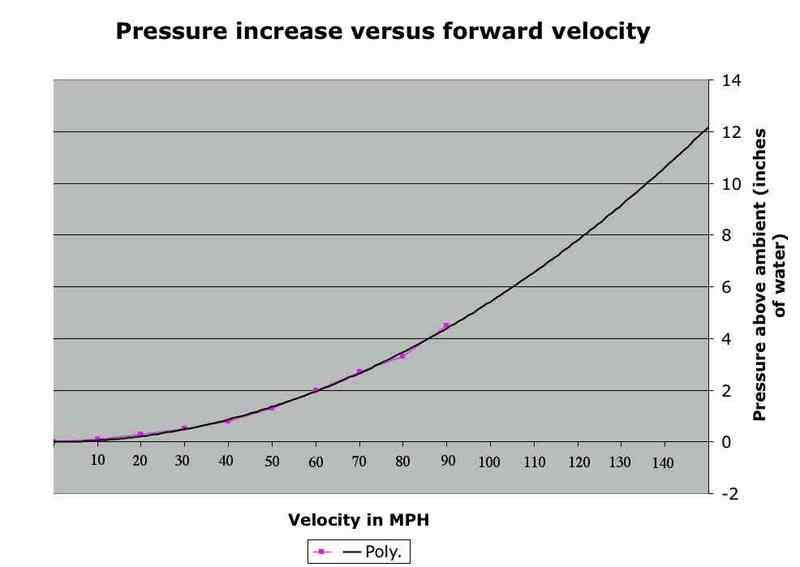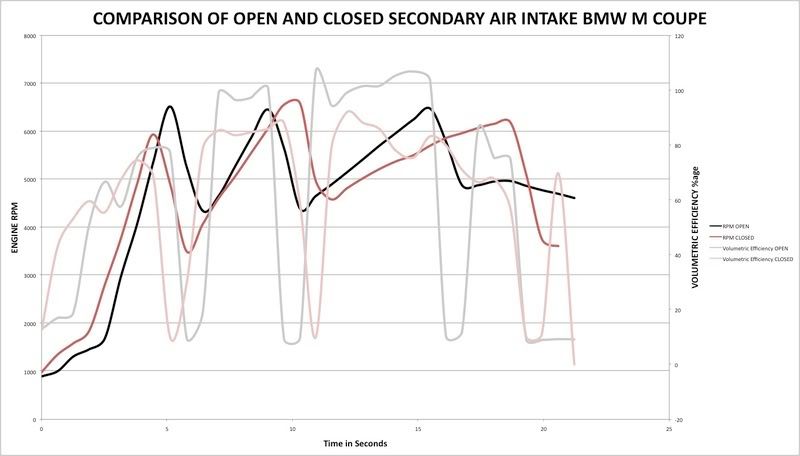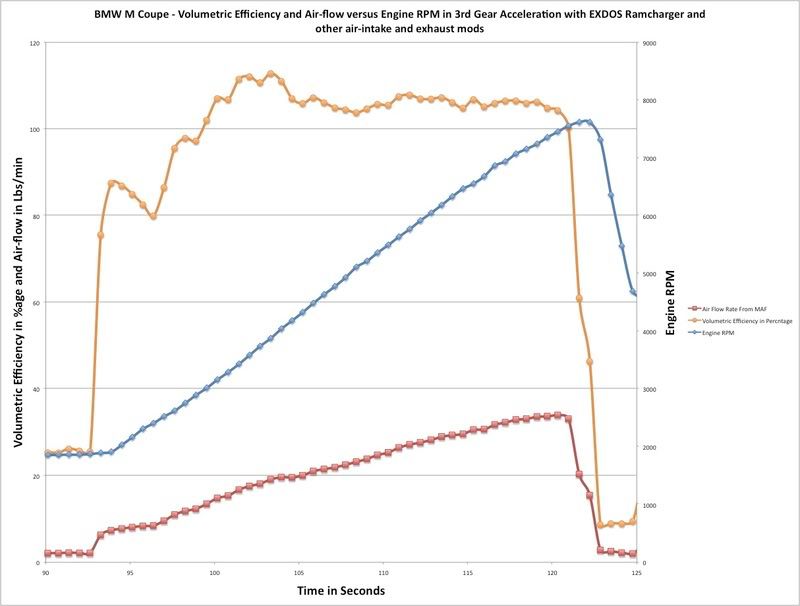Hi,
I'm glad you liked my post.
I'll address both of the main differences between our cars that you've identified:
1. I see that your car has two MAP sensors instead of a MAF. This should prove to be no problem to a datalogger like my DashDynoSPD, because it should be able to receive information from at least one, if not both, of the MAPs. The figures that you will obtain will be in the same format for air-flow (lbs/min or gm/sec), as from a MAF, so you would still be able to calculate Volumetric Efficiency (VE) from the data logged.
2. Although there is a very significant physical difference between the air intake of your E90 M3 and my Z3 M Coupe (S54 version), in essence (function), they are pretty much the same layout. The Z3 MC's air intake is NOT sealed. There is a snorkel in the left "brake duct" in the bumper, BUT, there is also an opening behind the headlamp that must function similarly to the two ports that vent from your hood.
Not only do I have a datalogger, I also have a Dwyer Magnehelic pressure gauge
http://www.dwyer-inst.com/Products/P...fm?Group_ID=26 which is a very accurate measuring device to detect air pressure differentials. You can pick these up on ebay for very little money see:
http://shop.ebay.com/?_from=R40&_npm...All-Categories If you decide to buy one, get one which has a range of around 6 inches of water. The gauge has three ports, to which you can attach some flexible tubing (fish tank stuff) and from these ports you can pass 5 or 6 metre length(s) of tubing(s) from the gauge mounted in your car to anywhere around the car (for aerodynamic measurements) or into your air intake system to see how your air-intake works. You can then record the air pressure changes under all the different driving scenarios to form a mental picture of what is happening under different scenarios: i.e cruising or Wide Open Throttle (WOT) at different speeds and in different gears.
Below is a graph which I've made showing the theoretical increase in dynamic pressure (ram effect) on the black line and the pink line is the dynamic pressure at different speeds which I have measured with my Magnehelic pressure gauge. As you can see, my recordings are pretty close to the theoretical values.

As you can see, I've recommended pressure gauge which can measure around 6 inches of water, the ram pressure at round 105mph, Since 1 atmosphere pressure (14.7lbs/square inch) equals 33.9 feet of water, and since 6 inches of water is less than a 1.5% increase in dynamic pressure most people who dismiss the possibility of ram effect being useful at relatively low speed (below 100mph+) use the 1.5% increase in dynamic pressure as being the reason to dismiss the possibility of ram-effect at low speed being useful. However, BMW engineers know better! MUCH BETTER.
Take a look at the dyno print out below, which I found on a BMW car forum in this thread:
http://www.e90post.com/forums/showthread.php?t=29831 Its for a E90 335 which appears to have a very similar air-intake to your E90 M3.
This graph is typical of the shape of the plots for torque and horsepower measured on most static dynos.

In this graph you can see that peak torque occurs at around 3500rpm and then it falls away with increasing revs, this has the knock-on effect of reducing the maximum HP (work done) available . But if you look at the plot of the Air/Fuel ratio beneath, you can see why this happens: AIR STARVATION. Air starvation on many dynos, particularly with BMW's with ram-effect air intakes, occurs because the fans placed in front of the car on the static dyno, do NOT replicate the flow (pressure) of air passing in front of the car in "real world" on-the-road conditions, therefore, an engine with a ram-air intake system cannot replicate its true performance, when on a dyno when the wheels are turning at a speed greater than around 70-80mph if the power of the fan is insufficient to replicate air speed (pressure) at the same speed as the wheels are moving on the rollers.
In comparison, take a look at a dyno graph below from data recorded by the DashDynoSPD of the performance of my MC in "real world" on-the-road conditions. The road I used when recording this data was level but a bit bumpy.

The car was driven at a steady 1500rpm on the cruise control in 3rd gear then the throttle was floored (WOT) and the car driven until the rev limiter kicked in. The drop off in values above 7000rpm is due to the relative slow data transfer speed of the ECU through the OBDII port on the Z3 MC. As you can see the torque plot shows a steady increase throughout the rev range (and in reality it does continue to the redline at 7600rpm). Obviously, air starvation does NOT occur in "real world" on-the-road conditions with a BMW ram-effect air-intake system. The Power output in my graph shows the "at the wheels" figure of 321bhp at 7200rpm, whereas, the published "at the flywheel" figure for the S54 engine in a Z3 MC is stated as producing 325bhp at 7600rpm, but this must be for an engine on a bench not benefitting from ram effect. For a S54 Z3 MC on a static dyno, the typical "at the wheels" horsepower is 275bhp, which is some 50bhp (15.38% losses) less than the "at the flywheel" figure. Therefore, the actual performance of my S54 engine in "real world" on-the-road conditions is producing an at the flywheel power output of around 375bhp, partly due to the benefits of the ram effect and my own air intake mods and also partly due to my "gutting" of the OEM silencers to make them "free-flowing".
The accuracy of the figures produced by the DashDyno can be confirmed by dyno runs that my car performed 12 months ago on a dyno with a very powerful fan. Here's one of the plots below.

Unfortunately, the DSC kept bringing the rev limiter into play at 6600rpm, so that a a full run up to 7600rpm couldn't be made. However, as you can see, the car was still pulling all the way through the entire rev range (in 3rd gear) right up until the rev limiter cut in.
As it happens, I experimented with covering the secondary air intake behind the headlamp on my MC, and I've prepared the graph below for you showing the difference in Volumetric Efficiency when the air intake is completely open and when partially closed off.

As you can see the VE barely gets above 90% when the air intake is partially blocked whereas the VE gets to 106% when it is OPEN as per OEM. These plots were performed on the same day and on the same run within five minutes of each other. I would therefore suggest that you should leave your air-intake completely OEM.
Finally, the VE is constantly changing and being regulated by the throttle opening. The VE can only ever be at max when at WOT. It is under these circumstances when the air intake requires all the air that it can get, and this will be when your under-hood ports really come into use. When my MC is travelling at a steady 30mph under cruise control, the VE is between 9%-20%, only. At 38mph under cruise control, VE is between 24% -34%, only. At Idle the VE is between 12% -13%.
I hope you find my data gives you a useful insight into what goes on inside your air-intake system.
EDIT
I've just done another graph from data that I recorded during a WOT acceleration right up to the the 7600rpm redline as below.

Once the car is travelling at above 3000rpm (60mph), the Volumetric Efficiency remains at over 100% proving that ram-effect does assist an engine to "breathe" at such low speeds and when dynamic air pressure has only increased by 2 inches of water - less than 0.5%!